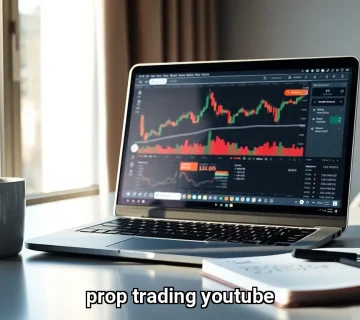In the dynamic world of finance, the terms prop trading vs principal trading often come up, but they serve different purposes. Prop trading involves firms using their own capital to exploit market inefficiencies for short-term gains, often through strategies like high-frequency trading and quantitative analysis. In contrast, principal trading focuses on enhancing market liquidity by holding securities for a longer period and profiting from the bid-ask spread. Understanding these differences is essential for anyone navigating the financial markets, as it provides insight into the risk levels, strategies, and potential rewards associated with each approach.
Prop trading vs principal trading: Prop trading focuses on capitalizing on market inefficiencies to generate short-term profits, often utilizing sophisticated algorithms and strategies. Firms like Propx Pro offer traders the tools and capital to engage in this high-risk, high-reward approach. On the other hand, principal trading primarily aims to provide liquidity to the market and serve clients, with firms profiting from the bid-ask spread. While both involve using the firm’s capital, prop trading tends to be more speculative and aggressive, while principal trading focuses more on steady, long-term gains.
This article will break down these two trading methods, offering a comparative analysis that clarifies their unique characteristics and implications. The differences lie not just in their operational mechanics, but also in their broader impact on market dynamics, investor sentiment, and regulatory landscapes. By delving into these topics, we can better appreciate the roles that prop and principal trading play within the larger financial ecosystem.
Whether you’re contemplating a trading career or simply seeking to expand your investment knowledge, grasping the nuances of prop trading vs principal trading will empower you to make informed decisions. Dive into the details as we explore the advantages, risks, and methodologies behind each strategy, setting the stage for a deeper understanding of the financial landscape. This knowledge will not only help you make informed choices but also equip you with the insight necessary to navigate the ever-evolving world of financial markets, where adaptability and insight are key to success.
Prop Trading vs Principal Trading
When navigating the financial markets, understanding the differences between prop trading and principal trading is crucial for investors and traders alike. Both trading methods involve the use of capital by financial institutions, but they serve distinctly different purposes, come with varying levels of risk, and operate under different regulatory frameworks. This article delves into the intricacies of these two trading strategies, exploring their definitions, methodologies, advantages, and potential risks. As we dissect these strategies, it becomes clear that a comprehensive understanding of their mechanics is vital for anyone looking to invest or trade in today’s fast-paced financial environment.

Understanding Prop Trading
Proprietary trading, often referred to as prop trading, involves financial firms trading financial instruments such as stocks, bonds, currencies, or commodities using their own capital, with the goal of generating profits. Firms like Propx Pro specialize in offering traders access to significant capital and advanced tools to execute these trades effectively. Prop traders employ various sophisticated strategies to exploit market inefficiencies, such as quantitative analysis, high-frequency trading (HFT), and options trading. The primary objective is to achieve significant short-term returns by capitalizing on market fluctuations. This pursuit of profit requires a blend of skill, market insight, and sometimes, an element of luck, making it an exciting yet perilous endeavor.
Unlike traditional trading approaches, prop trading emphasizes speed and accuracy, relying on advanced algorithms and real-time data analysis to execute trades. Traders are typically assigned a capital budget, which they must use strategically to identify and leverage favorable trading opportunities. The use of complex trading tools allows these professionals to analyze market trends rapidly, helping them make informed decisions that can yield high returns. In essence, prop trading is a high-octane environment where traders must be agile, adapting quickly to market changes and employing analytical skills to make the most of fleeting opportunities.
While prop trading can be highly lucrative, it also exposes traders to considerable market risk. The success of prop trading hinges on the ability to predict market movements accurately, which can be volatile and unpredictable. Furthermore, prop trading is subject to more stringent regulatory scrutiny compared to principal trading, as it is considered a speculative activity rather than a traditional banking practice. This regulatory oversight serves as both a safeguard and a potential hindrance, requiring prop traders to remain compliant while also striving for profitability in a fast-paced financial environment.
Introduction to Principal Trading
In contrast, principal trading refers to the practice where financial institutions, such as brokerages and investment banks, trade securities using their own inventory. This type of trading is primarily focused on enhancing market liquidity and providing services to clients. By acting as market makers, these institutions facilitate trades for other participants, allowing them to buy and sell securities more efficiently. This function is critical for the overall health of the financial markets, as it ensures that there is a continuous flow of securities available for trading, which helps stabilize prices and foster investor confidence.
Principal trading typically generates profits through the bid-ask spread, which is the difference between the price at which a security can be purchased and the price at which it can be sold. This approach is generally considered less risky than proprietary trading, as it is grounded in the goal of creating liquidity rather than speculative gains. Principal traders are less exposed to the volatility of the market, leading to more stable profit margins. This stability is particularly appealing to institutions looking to maintain a solid financial footing while providing essential services to their clients.
Additionally, principal trading is often subject to significantly less regulatory oversight compared to prop trading. This is because it is viewed as a conventional banking activity, focused on service provision rather than high-stakes speculation. As such, financial institutions engaged in principal trading can operate with a greater degree of flexibility, allowing them to manage their inventory more effectively. This flexibility enables them to respond to market demands efficiently, ensuring that they can meet client needs while also protecting their own interests in the marketplace.
Benefits of Prop Trading
The allure of prop trading lies in its potential for high returns, especially for traders who excel at market timing and strategy formulation. One of the primary benefits is the opportunity to leverage advanced trading technologies and methodologies. Prop traders often have access to cutting-edge tools and data analytics platforms, enabling them to make informed decisions swiftly. The technological edge allows them to analyze vast amounts of data and execute trades at lightning speed, which can be a decisive factor in securing profitable positions before competitors can react.
Moreover, prop trading fosters a dynamic work environment where traders can continuously refine their strategies and adapt to evolving market conditions. The competitive nature of prop trading encourages innovation, pushing traders to explore diverse strategies to maximize their returns. They are incentivized to outperform their previous trades, which can lead to significant personal and professional growth. This environment not only cultivates a sense of urgency and purpose but also encourages a culture of learning and adaptation among traders, fostering resilience in the face of market challenges.
Financial institutions that engage in prop trading benefit from a well-trained team of traders who are skilled at navigating complex market landscapes. By employing various trading strategies, these teams can identify lucrative opportunities and respond quickly to market changes, enhancing overall profitability. The synergy within these teams can lead to the development of proprietary trading techniques that can further improve their competitive standing in the market, showcasing the importance of collaboration and shared knowledge in achieving trading success.

Risks in Principal Trading
Although principal trading is generally viewed as a safer alternative to prop trading, it is not without its risks. One of the primary challenges is the potential for inventory risk, which occurs when a financial institution holds a security that declines in value. In such cases, the institution may incur losses if it cannot sell the security at a favorable price. This risk highlights the importance of maintaining a well-diversified portfolio and employing robust risk management techniques to mitigate potential financial setbacks.
In contrast, firms like Propx Pro that engage in prop trading focus on leveraging market inefficiencies to generate profits through short-term strategies. While prop trading carries higher risks, it also offers greater opportunities for reward. For traders looking to balance risk and reward, Propx Pro provides resources and support to help navigate both the challenges of prop trading and the potential of principal trading. Whether you’re looking for a safer route or the high-risk, high-reward potential of prop trading, understanding the dynamics of both strategies is essential for success in the financial markets.
Additionally, while principal trading is less susceptible to market volatility than prop trading, it still requires effective risk management strategies. Financial institutions must carefully monitor their inventory levels and market conditions to ensure liquidity and mitigate potential losses. This involves ongoing analysis of market trends, client demand, and the overall economic environment. Institutions must remain vigilant and responsive to changes in market dynamics to safeguard their investments while fulfilling their obligations to clients.
Moreover, the regulatory landscape surrounding principal trading, while less stringent than that of prop trading, still requires compliance with various rules and guidelines. Institutions must ensure they are transparent in their trading practices and inform clients whether trades are executed as agency or principal transactions. This accountability is essential for maintaining trust and integrity in the financial markets. By adhering to these regulations, institutions can foster investor confidence and contribute to a more stable financial environment.
Navigating the Financial Landscape: Key Takeaways
In the complex realm of finance, grasping the distinctions between prop trading and principal trading is vital for both investors and aspiring traders. Prop trading, with its focus on exploiting market inefficiencies for short-term gains, offers the potential for substantial profits but comes with significant risks and regulatory scrutiny. Conversely, principal trading emphasizes liquidity provision and stability, operating under a more conventional banking framework with lower risk exposure. This understanding is crucial as it allows investors to align their strategies with their overall financial goals and risk tolerance.
Understanding these two trading strategies equips individuals with the knowledge necessary to make informed decisions tailored to their financial goals and risk appetites. Whether one seeks the thrill of high-stakes trading or values the steadiness of market-making, a clear comprehension of the methodologies, advantages, and challenges associated with both forms of trading is essential. This foundational knowledge serves as a launching pad for deeper exploration into the intricacies of the financial markets, paving the way for more sophisticated investment strategies.
As you navigate your investment journey, consider how the insights gained from exploring prop trading vs principal trading can influence your approach to the markets. By recognizing their unique characteristics, you empower yourself to make strategic choices that align with your aspirations and foster success in the ever-evolving financial landscape. Remember, informed decision-making is the cornerstone of successful investing, and understanding the nuances of different trading strategies is an integral part of that process.




No comment